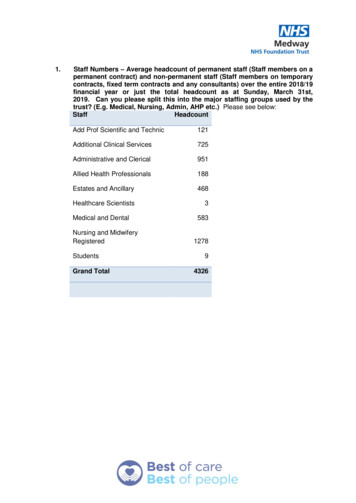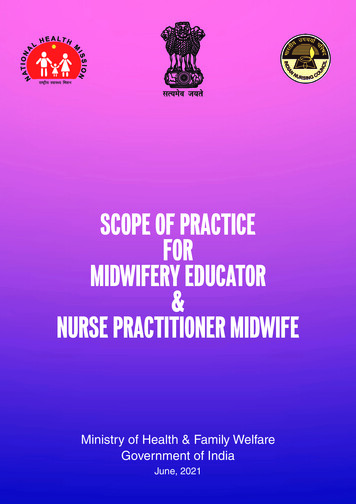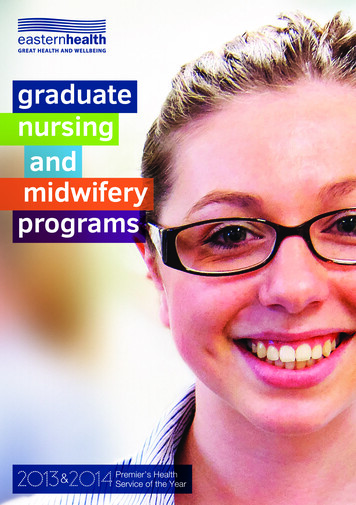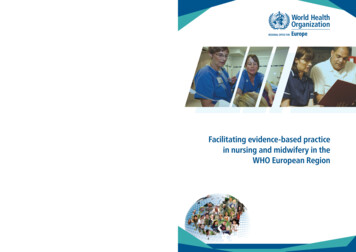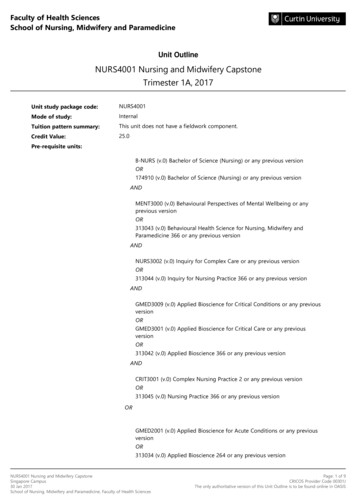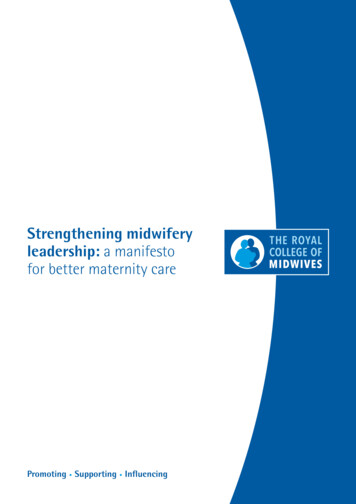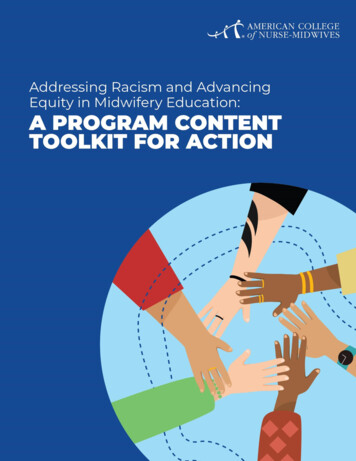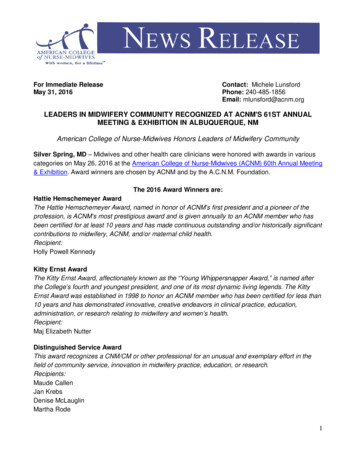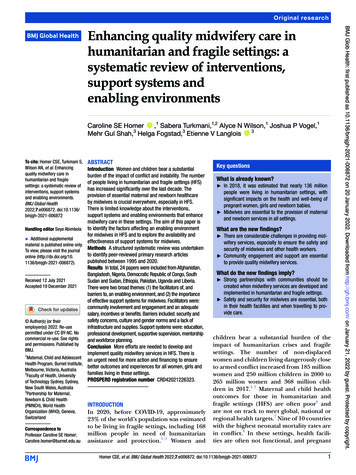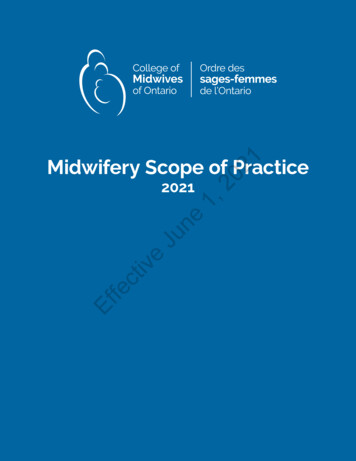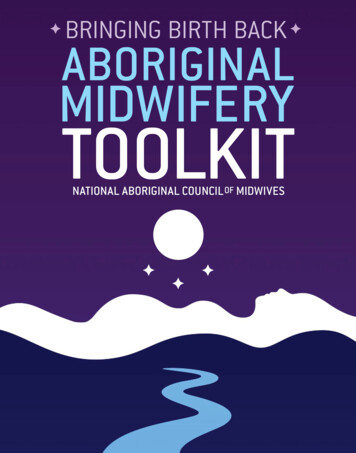
Transcription
BRINGING BIRTH BACKABORIGINALMIDWIFERYTOOLKITNATIONAL ABORIGINAL COUNCIL OF MIDWIVES
Table of ContentsSECTION ONE:A Call to Action .1-11Chapter 1 An Introduction to the Toolkit. 1-21Chapter 2 Aboriginal Midwifery in Canada. 1-61Chapter 3 Aboriginal Midwifery in a Global Context. 1-37SECTION TWO:Current Aboriginal Maternal Health Needs. 2-11Chapter 4 What is your community’s birth history?. 2-31Chapter 5 Workshop idea:Asset mapping for maternal health. 2-61Chapter 6 Workshop idea:Understanding impacts through body mapping art . 2-11Chapter 7 What is the birth rate in your community? . 2-23SECTION THREE:Midwifery Regulation, Governance, and Models of Care. 3-11Chapter 8 Midwifery Regulatory Frameworks. 3-21SECTION FOUR:Building Midwifery Services Closer to Home. 4-11Chapter 9 Midwifery Education. 4-21Chapter 10 Building a Midwifery Practice. 4-71Appendix 1: References and Suggested Readings. A-11Appendix 2: Glossary of Terms. A-31Appendix 3: Vital Statistics Offices. A-71Appendix 4: First Nations and Inuit Health Regional Offices. A-91
SECTION ONEA Call to ActionThis section of the Toolkit includes: C HAPTER 1An Introduction to the Toolkit C HAPTER 2A general history of Aboriginal Midwifery inCanada and an overview of current AboriginalMidwifery practices in Canada C HAPTER 3Aboriginal Midwifery in a global context includingan overview of a rights-based approach toAboriginal maternal healthAboriginal midwife Nathalie Pambrun weighing a baby1-1
CHAPTER 1An Introduction to the ToolkitAbout NACMMidwives play an essential role in the care of women and theirfamilies. In Canada today, very few Aboriginal communitieshave access to midwives and most women must birth theirbabies away from their communities. Aboriginal communitiescontinually experience poorer health outcomes than thegeneral populations of their home countries. Maternal andinfant outcomes are a fundamental indicator of the healthof populations and there are marked differences betweenAboriginal and non-Aboriginal outcomes. Aboriginalcommunities also experience higher birth rates, youngerpopulations, significant barriers to accessing health care, andhigher rates of suicide, addiction, incarceration, family violence,and apprehension of children. The health and well-being ofAboriginal mothers and their babies is central to understandinghow these disparities can be challenged and overcome(Olson et al, 2012).NACM is an organization under the umbrella of the CanadianAssociation of Midwives (CAM). As an active member of CAM,NACM represents the professional development and practiceneeds of Aboriginal midwives to their responsible healthauthorities in Canada and the global community. The missionof NACM is to promote excellence in reproductive health carefor Inuit, First Nations, and Métis women.According to the United Nations Population Fund (UNFPA),“increasing access to quality midwifery care has become a focusof global efforts to realize the right of every woman to the bestpossible health care during pregnancy and childbirth.” TheNational Aboriginal Council of Midwives (NACM) advocatesfor the increase in access to midwifery care for all Aboriginalcommunities which is consistent with the UN Declaration onthe Rights of Indigenous Peoples.This Toolkit is also available online and includesvideos, podcasts, and various supporting materials.Please visit www.aboriginalmidwives.ca/toolkitfor more information.1-2NACM represents Aboriginal midwives across Canada. Itspurpose is to serve as a knowledgeable resource and advocatefor Aboriginal Midwifery, Aboriginal women’s health, andmaternal and child health care – including birth – in Aboriginalcommunities. NACM’s mission is: to promote excellence in reproductive healthcare for Inuit, First Nations, and Métis women.We advocate for the restoration of midwiferyeducation, the provision of midwifery services, andchoice of birthplace for all Aboriginal communitiesconsistent with the UN Declaration on the Rightsof Indigenous Peoples. As active members of theCanadian Association of Midwives, we representthe professional development and practice needsof Aboriginal midwives to the responsible healthauthorities in Canada and the global community.In fulfilment of this mission, NACM has developed theproject, the “Campaign to Protect the Future of AboriginalCommunities” in order to promote the profession of midwiferyand increase access to midwifery care for all Aboriginalcommunities. This Toolkit is a part of this ongoing project.1-3
The ToolkitThe Toolkit has been designed to provide information andactivities for Aboriginal communities interested in learningmore about maternal and infant health and midwifery care.The Toolkit provides both background information andsuggested workshops in order to find out information aboutyour particular community and where maternal and infanthealth could be enhanced.NACM understands that accessing midwifery care in Aboriginalcommunities is a complex undertaking. It includes addressingissues of inter-governmental jurisdiction and access to services,midwifery education, and Aboriginal rights and sovereignty.NACM recognizes the diversity in Aboriginal communitiesacross Canada. It is important to take this diversity into accountwhen developing models of midwifery care for Aboriginalpeoples and to address the historical, cultural, and spiritualrealities of each community when restoring midwifery care toAboriginal populations.The sections do not have to be read in order and the Toolkit wasdesigned so that readers can move between sections dependingon their needs. Appendix 2 is a glossary of terms common tomidwifery and maternal, newborn, and infant health care.These terms are used frequently throughout the Toolkit.Section One includes: Chapter 1: an introduction to the Toolkit Chapter 2: a general history of Aboriginal Midwifery inCanada and an overview of current Aboriginal Midwiferypractices in Canada Chapter 3: a description of Aboriginal Midwifery in a globalcontext including an overview of a rights-based approach toAboriginal maternal healthThe Toolkit is organized into four main sections. These are: Introduction: A Call to Action Assessing Current Maternal Health Needs Midwifery Regulation, Governance, and Models of Care Developing Midwifery Services Closer to HomeMidwives and family members in Inukjuak, Nunavik1-41-5
CHAPTER 2Aboriginal Midwifery in CanadaThe work of an Aboriginal MidwifeAn Aboriginal midwife is a committed primary health careprovider who has the skills to care for pregnant women, babies,and their families throughout pregnancy and after the birth ofthe baby. She is also knowledgeable in all aspects of women’smedicine and provides education that helps keep the familyand the community healthy. A midwife promotes breastfeeding,nutrition, and parenting skills. A midwife is the keeper ofceremonies, such as puberty rites for young people. She is aleader and mentor – someone who passes on important valuesabout health to the next generation.Aboriginal communities across Canada have always hadmidwives. It has only been in the last hundred years thatthis practice has been taken away from communities. Thisoccurred for a number of reasons, including colonization andchanges in the health care system in Canada. As a result oflosing midwifery, many women in rural and remote Aboriginalcommunities are currently required to deliver their babies andaccess care outside their communities. In many northern orremote settings, pregnant women have to leave their familiesand communities for many weeks – or even months – prior tothe birth. This means many women often give birth without anyfamily support.Aboriginal midwives in these communities offer an importantoption for women and their families: the opportunity to stay athome and to be together to welcome the baby into the familyand the community. The vision of these midwives is to oneday see “an Aboriginal midwife working in every Aboriginalcommunity.” This Toolkit provides information about theprocess of creating a maternity care system that works for yourcommunity and returning birth closer to home. UnderstandingAboriginal Midwifery is an important part of this journey.1-6Aboriginal midwives are health professionals who provideprimary care to women and their babies during pregnancy,labour, birth, and the early parenting period. As a primary careprovider, an Aboriginal midwife may be the first and only healthprofessional a pregnant woman sees when she is pregnant.Aboriginal midwives work in partnership with a woman and arefully responsible for clinical decisions and the management ofcare during the childbearing year.1-7
Core values of Aboriginal MidwiferyMidwives also work with health professionals like doctors,Recognizing that the good health and well-being of Aboriginalpediatricians, or other specialists when necessary andappropriate to provide complete and integrated care.An Aboriginal midwife can work in a variety of settings,depending on the community: from birth centres, to clinics,to hospitals, to the family home.women and their babies is crucial to the empowerment ofAboriginal families and communities, Aboriginal midwivesuphold the following core values:Aboriginal midwives strive to provide compassionatecontinuous care. This means a woman gets to know hermidwives well, through longer prenatal and postnatal visits,and through continuous support during labour and delivery.Midwives are available to women on a 24-hour on-call basis.This allows for the building of trusting relationships.Continuity of care is also reflected within a woman’sreproductive lifetime as Aboriginal midwives make theconnection between birth, puberty, childbearing, and elderhood and provide care for pregnant women within this cycle.Aboriginal Midwifery competencies can also include lookingafter the woman and her infant outside the childbearing year(well woman and baby care) as well as general reproductivehealth care for women of all ages.The diagram on page 1-7 shows how an Aboriginal midwifespends her time. Midwives are not only responsible fortaking care of women and babies, their role extends into thecommunity as well as working with the health care systems.Midwives often find themselves very busy, and it is importantto try and find balance between all of these areas, includingself ASTFEEDINGCULTURAL SAFETYCLINICAL EXCELLENCEEDUCATIONRESPONSIBILITY1-9
Aboriginal Midwifery is.HEALINGAboriginal midwives enhance the capacity of acommunity to heal from historical and ongoing traumas,addictions, and violences. Aboriginal midwives drawfrom a rich tradition of language, Indigenous knowledge,and cultural practice as they work with women to restorehealth to Aboriginal families and communities.Laurie Jacobs is a midwife at theSix Nations Birthing Centre, Ontario1-11
Aboriginal Midwifery is.BONDINGWell-being is based on an intact mother and babybond t hat must be supported by families, communitiesand duty bearers in health and social service systems.Cheryllee Bourgeois is a midwife withSeventh Generation Midwives, Toronto, Ontario1-13
Aboriginal Midwifery is.EDUCATIONAboriginal midwifery education and practice respectdiverse ways of knowing and learning, are responsive to Aboriginal women, families and communities and must beaccessible to all who choose this pathway.Aimo Nauyuk is a student midwife at Arctic College, Cambridge Bay, Nunavut1-15
Aboriginal Midwifery is.CULTURALSAFETYAboriginal midwives create and protect the sacredspace in which each woman, in her uniqueness, canfeel safe to express who she is and what she needs.Kristi Shawana is a midwife at theSix Nations Birthing Centre, Ontario1-17
Aboriginal Midwifery is.RESPECTAboriginal midwives respect birth as a healthyphysiologic process and honour each birth as aspiritual journey.Nathalie Pambrun is a midwifein Sackville, New Brunswick1-19
Aboriginal Midwifery is.BREASTFEEDINGAboriginal midwives uphold breastfeeding as sacred medicine for the mother and baby that connects the bodies of women to the sustaining powersof our mother earth.Diane Simon is a student midwife atRyerson University, Ontario1-21
Aboriginal Midwifery is.RESPONSIBILITYAboriginal midwives are responsible for upholdingthe values of Aboriginal Midwifery through reciprocaland equal relationships with women, families and theircommunities.Evelyn Harney is a midwife in the Okanagan Valley, BC1-23
Aboriginal Midwifery is.CLINICALEXCELLENCEAboriginal midwives uphold the standards andprinciples of exemplary clinical care for womenand babies throughout the life cycle. This includesreproductive health care, well woman and babycare and the creation of sacred, powerful spaces forAboriginal girls, women, families, and communities.Annie Tukulak is a midwife at theInuulitsivik Health Centre, Puvirnituq, Quebec1-25
Aboriginal Midwifery is.COMPASSIONAboriginal midwives act as guides and compassionatec aregivers in all Aboriginal communities, rural, urbanand remote. The dignity of Aboriginal women isupheld through the provision of kind, considerate andrespectful services.Darlene Birch is a midwife atNorway House Cree Nation, Manitoba1-27
Aboriginal Midwifery is.AUTONOMYAboriginal women, families and communities havet he inherent right to choose their caregivers and to be active decision makers in their health care.Sacheen Seitcham is a midwife atSnuneymuxw/Ahousaht, BC1-29
YKNWTNUBCABNF/LMBSKNFQCONPEINBNSAboriginal Midwifery practicesAboriginal Midwifery practicesin CanadaWhile there are Aboriginal midwives currently practicingacross Canada, there are specific midwifery practices dedicatedto providing care to Aboriginal communities. In this section,these eleven midwifery practices are outlined.1-301-31
1. Inuulitsivik Health Centre, Nunavik, Quebec:Since 1986, midwives have been the on-call, primary careproviders for maternity care for all women. This program islocated in three communities along the Hudson Bay coast. Thebirth centres are a midwifery-led collaborative model of care thatinvolves effective teamwork between midwives, physicians, andnurses working in remote villages and at regional referral centres.Transfers from the community to the south have been greatlyreduced, from 91 percent in 1983 to less than 9 percent in 1998.Midwifery education is a key component of the birth centres,and training community members as midwives has sustained theprogram and been one of its key elements of success.2. Tulattavik Health Centre, Nunavik, Quebec:The situation on the Ungava Coast was different until fairlyrecently, since maternity services were provided until 2004 byphysicians and nurses in Kuujjuaq. However, since 2009, midwiveshave been providing maternity services. Since the introduction ofmidwives in the community, transfer rates have significantly gonedown and satisfaction for women and their families has increased.There are currently four midwives working in Kuujjuaq and theyare the on‑call primary care providers for all women on the Coast.Additionally, a community-based training program just started inAugust 2013 in Kuujjuaq.3. Rankin Inlet Birthing Centre (RIBC), Nunavut:RIBC was established in 1993 and provides women with theoption of community-based birthing. The need for this servicewas identified by many community members, political leaders,health care providers, and researchers involved in the region.The midwives provide prenatal care and attend births. A PerinatalCommittee conducts weekly reviews involving risk assessmentsand suitability of women to give birth in the community.A Maternity Care Worker Program and Midwifery Training arecurrently being offered through Arctic College.4. Cambridge Bay Birth Centre, Nunavut:In January 2010, the birth centre in Cambridge Bay was openedand began offering maternity services, including low-risk1-32deliveries. The midwives working at the centre are also involvedin midwifery education and use the same model of trainingavailable in Rankin Inlet offered through Nunavut Arctic Collegein Cambridge Bay.5. Fort Smith Health and Social ServicesMidwifery Program, Northwest Territories:In April 2005, the Fort Smith Health and Social ServicesAuthority (FSHSSA) officially integrated midwifery servicesinto its programming after a three- year developmental project.Midwives had been working in the community for many years inprivate practice and chose to become a part of the local healthcare system. A key part of the project was developing a multidisciplinary approach to maternity care services. This includedforming a Maternity Care Committee made up of midwives,physicians, nurses, and clinical care managers. The Committeemeets regularly to review clinical care plans and discuss variousissues regarding clinical care and risk assessment.6. K inosao Sipi Midwifery ClinicNorway House Cree Nation, Manitoba:This midwifery practice was established in conjunction with thekanaci otinawawasowin Baccalaureate Program (KOBP) at theUniversity College of the North in 2006. The clinic is located in theFirst Nations and Inuit Health hospital in Norway House and hasundergone numerous challenges in its implementation process.Currently, the midwifery clinic serves women both in pre- andpostnatal periods, and arranges transportation to the tertiarycentre for their clients. The development of a low-risk electivebirthing program is still being negotiated.7. Seventh Generation Midwives Toronto:This urban Aboriginal Midwifery practice was established bya group of Registered Aboriginal Midwives and Aboriginalmidwifery students in 2005 with a focus on serving the urbanAboriginal community in downtown Toronto. SGMT workswith the urban community to improve Aboriginal maternal andinfant health by supporting women to reclaim control of birthfor themselves, including the choice to incorporate traditional1-33
18. t eachings and ceremonies. The midwives provide prenatal carefrom the beginning of pregnancy to six weeks postpartum andhave a special designation from the university-based MidwiferyEducation Programs in Ontario to prioritize clinical placementsfor Aboriginal students at their clinic. The Toronto Birth Centrerecently opened and SGMT also work out of this centre. Theyattend births at home, in their clinic, at the Toronto birth centre,and at Sunnybrook hospital.18. Tsi Non:we Ionnakeratstha Ona:grahsta’ Six NationsMaternal and Child Centre, Ontario:Opened in 1996, the birth centre consists of Aboriginal midwivesand support staff and provides a balance of traditionaland contemporary midwifery services and programs. Theestablishment, direction, and ongoing operation of the practiceis a community-driven process, supported by an AdvisoryCommittee and a Grandparents Committee. The midwives workunder an exemption clause in the Midwifery Act that allowsthem to practice and serve families in southwestern Ontario.The Centre also supports an Aboriginal Midwifery EducationProgram.19. Kontinenhanónhnha Tsi Tkaha:nayen TyendinagaMohawk Territory, Ontario:This private practice opened in May 2012 with a focus onreturning traditional birthing practices to Tyendinaga. Themidwives work under an exemption clause and provideAboriginal women and families the option of community-basedbirthing in both rural and urban areas. The Kenhte:ke BirthAdvisory Working Group was formed in February 2012 todevelop plans for the Kenhte:ke Birthing Centre.10. Neepeeshowan Midwives, Attawapiskat, Ontario:‘Neepeeshowan’ is Cree for a blooming flower. This practiceopened in the Fall of 2012 in Attawapiskat, a Cree community of1,900 people located 500 km north of Timmins. At the moment,there is one midwife but there are plans to have two midwivesin Attawapiskat, provide access to midwifery education for Creewomen, and eventually expand midwifery services to all coastal1-34communities. Currently, Neepeeshowan Midwives care for mostpregnant women of the community. Planned community birthsfor women experiencing healthy pregnancies are starting totake place. This new practice is the culmination of decades ofadvocating from women of Attawapiskat. It provides care andservices in the Weeneebayko Area Health Authority (WAHA),which includes the communities of Moose Factory, Moosonee,Fort Albany, and Attawapiskat.11. K ’Tigaaning Midwives, Powassan, Ontario:Two Aboriginal midwives bought in October 2013 a longestablished practice in the North Bay region and renamed itK’Tigaaning Midwives in honour of their community in Nipissing.The catchment area includes North Bay, Nipissing First Nationas well as surrounding areas. They are delighted to be able toprovide care in their home community.12. T he Ionteksa’tanoronhkwa “child-cherishers”Homebirth Midwives of AkwesasneTheir mission is to revitalize their culture and strengthen theirpeople through a modern Onkwehon:we midwifery practice thatuses both traditional knowledge and non-Indigenous midwiferytraining to ensure the safety of the child and the well-beingof the family. The midwives have been quite interested in theprospect of developing a birth centre at Akwesasne. Their hopeis that a birth centre would give clients a safe and comfortableplace to give birth as a viable alternative to the hospital setting.13. North Channel Midwifery, OntarioNorth Channel Midwifery is a solo practice operated by aregistered Aboriginal midwife. She provides midwifery carefrom Massey to Thessalon First Nations, including communitiesin between.The next section of the Toolkit will look deeper at thecurrent maternal health needs of Aboriginal communitiesand provide suggestions and methods of researching howto find out this information.1-35
CHAPTER 3Aboriginal Midwiferyin a Global ContextAboriginal Midwifery in Canada is unique in its history andits practice. It is important to look at some of the other waysmidwifery is practiced in other countries. While there arevarious models of midwifery care, it is useful to draw on thephilosophies and practices of Indigenous midwives in otherplaces. This knowledge can inform the development of ourown vision of midwifery practice in our communities.Inter-cultural exchange between Aboriginal Midwifery studentsand Mayan Elders at a traditional medicine campnear Clearwater Lake, ManitobaKerry Bebee, Aboriginal midwife, with mom and babyKaryn and Grace Recollet1-36The following lists a few organizations and education programsfor Indigenous midwives around the world. This list includesorganizations from New Zealand, Mexico, Guatemala, andAustralia.Nga Maia O Aotearoa Me Te Wai Pounamu, New ZealandNga Maia is a national body that represents Maori birthing.The kaupapa of Nga Maia focuses on Mama, Pepi, Whanau andpromoting Matauranga Maori in pregnancy and childbirth. Startedin 1993, Nga Maia is the largest collective of Maori midwives inAoetearoa me Te Waipounamu. They “acknowledge the heart anddetermination of our membership past and present to realize thedreams and desires for Whanau to have birthing knowledge thatupholds the significance of creation and the Mana of all involved inthe process of birth.” Nga Maia also strives to “develop frameworksfor practice that acknowledge the validity and significance ofWhanau being offered care that reaffirms Maori epistemology/knowledge as a birth right of all Maori through whakapapa.” Thiscollective “provides Kaupapa Maori resources for Whanau to accessin order to weave the concepts that speak to them into their birthingstories and to provide a space for Maori midwives to generate anddebate our ways of knowing and walking beside Whanau.” VisitNga Maia’s website and resource materials: www.ngamaia.co.nz1-37
ACAM Maternity Center:Concepcion Chiquirichapa, GuatemalaACAM is a birth centre and cultural project founded, owned, andoperated by traditional Maya midwives in the Western Highlandsof Guatemala. In 2004, ACAM ‚“Casa Maternal de Nacimiento yla Comienza de Esperanza”, opened the birth center, educationaland community space, clinic and guest quarters. Grown out of acollaboration of Mayan and North American midwives, ACAM’svision is : 1) the preservation of Maya midwifery by strengtheningMaya midwifery as an institution and educating new midwives;2) traditional healing through the promotion of the physical,emotional, and spiritual health of the community; 3) the addressingof the roots of disease, pregnancy loss, maternal and infant mortality;4) the health of Mother Earth, the environment; 5) the promotionof community development and civic participation. The role of themidwives goes beyond that of providing prenatal consultationsand attending births. The midwives are trusted in the communityand many villagers bring their sick children and receive medicinesand herbs for upper respiratory infections, skin infections, diarrheaand other primary care issues. The midwives conduct ceremoniesand rituals for the relief of trauma and also run workshops for thecommunity led by a psychologist who is Maya and specializes inpost‑traumatic stress. They have begun weekly radio programs inMam on various health related topics. For more information, visittheir website: www.mayamidwifery-acam-imlusa.orgCASA: Center for the Adolescents ofSan Miguel de Allende, MexicoFounded in 1981, CASA is a grassroots, youth-driven organizationthat provides comprehensive education and health services toadolescents and their families, particularly in vulnerable ruralcommunities. Under the framework of social justice, CASA’s nineprograms promote family planning, human rights, gender equity,basic health care, professional midwifery, prevention of violence,and childhood development. CASA’s maternity hospital, midwiferyschool, daycare center, public library, and community outreachprograms operate under an integral community-based educationmodel which teaches others to teach. It has enabled generations1-38of CASA’s staff to transform the lives of thousands in some of themost remote communities of Mexico. The lessons learned haveenabled CASA to change public policy and impact the country’smaternal and newborn health system through professionalmidwifery advocacy efforts.The CASA Professional Midwifery School opened in 1996 and isstill Mexico’s only government-accredited midwifery school. Theprogram is open to all women who have finished at least nine yearsof formal education and gives preference to women from rural areaswho are related to traditional midwives. CASA midwives are expertsin primary preventive care, as well as normal pregnancy and birth.They accompany women throughout their reproductive cycle andalways promote gender equality. For more information, visit theirwebsite: www.empowercasa.orgCATSIN: Congress of Aboriginal and Torres Strait IslanderNurses and Midwives, AustraliaCATSIN was founded in 1997 to formally represent Aboriginaland Torres Strait Islander nurses and midwives and is made upof nurses, midwives, students, and retired nurses and midwives.CATSIN’s primary aim is to increase the recruitment and retentionof Aboriginal and Torres Strait Islander peoples into nursing andmidwifery. CATSIN is also dedicated to ensure all nurses andmidwives have meaningful, discrete courses on Aboriginal andTorres Strait Islander health, history, and culture in all coursesleading to enrolment, registration or endorsement as a nurse ormidwife. CATSIN aims to ensure Aboriginal and Torres StraitIslander nursing and midwifery students have targeted support andassistance to ensure their access to education is equitable. CATSINrepresents Aboriginal and Torres Strait Islander nurses and midwivesthroughout the nursing and midwifery professions, to governmentsand in Aboriginal and Torres Strait Islander health. For moreinformation, visit their website: catsin.org.au1-39
Understanding a rights-basedapproach to Maternal Health CareAccording to a report by the UN Special Rapporteur on Health,“sexual and reproductive health are integral elements of theright of everyone to the enjoyment of the highest attainablestandard of physical and mental health.” In the context ofAboriginal communities in Canada, the right to health isconnected to the rights of Aboriginal peoples in the CanadianConstitution, as well as the UN Declaration on the Rights ofIndigenous Peoples.When we speak of a rights-based approach we mean that weuse a human rights framework in the process of understandingand developing maternal health care services. For example,according to Amnesty International’s Toolkit on maternal healthand sexual and reproductive health rights (2012), women havea right to the following services: primary health care services throughout a woman’s life education and information on sexual and reproductive health sexual and reproductive health care services, such as familyplanning services prenatal (before and during pregnancy) and postnatal(after pregnancy) health services skilled medical personnel to attend the birth emergency obstetric care1-401-41
In a policy statement by the Society of Gynaecologists andObstetricians of Canada (SOGC) for Aboriginal peoples inCanada (2011), these rights also include the right to: make informed health decisions be free from harmful practices, including discriminationagainst two-spirit people, gender-based and other forms ofdiscrim
realities of each community when restoring midwifery care to Aboriginal populations. The Toolkit is organized into four main sections. These are: Introduction: A Call to Action Assessing Current Maternal Health Needs Midwifery Regulation, Governance, and Models of Care Developing Midwifery Services Closer to Home
